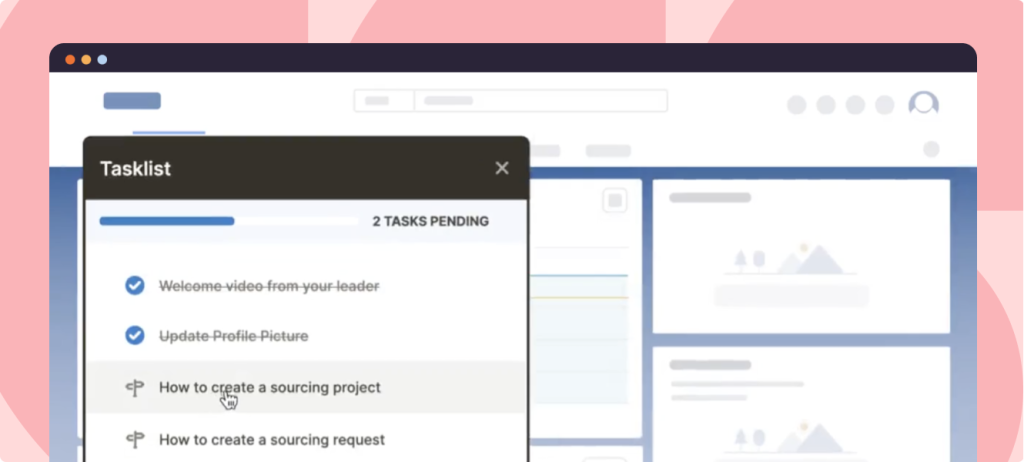Organizations are only as adaptable as their workforce. Nearly 49% of learning and development professionals report that employees lack the skills to execute business strategy effectively. This growing skills gap makes learning and development (L&D) more critical than ever before.
However, simply offering traditional training programs isn’t enough. Organizations must prioritize continuous learning, AI-driven personalization, learning embedded in the flow of work, and immersive training experiences. L&D leaders must stay ahead of emerging trends to equip employees with the right skills at the right time and in the right way.
Multiple reports and articles covering the latest L&D trends are published every year, making it hard to stay on top of how our industry is progressing. Therefore, in this article, we have summarized the key L&D trends that are shaping the future of workplace learning, helping businesses build resilient, future-ready teams in 2025 and beyond.
What are the most impactful L&D trends in 2025?
- Upskilling and reskilling for a systematic, future-focused L&D approach
- L&D programs that support AI adoption
- AI-powered learning experiences
- Microlearning
- Embedding learning in the flow of work
- Simulation-based training
- L&D analytics
- Emotional intelligence and cross-cultural social skills training
- Agile approach to skills development and learning approaches
- Edutainment and social-based community learning
- Gamification
- Balancing DEI training in a highly politicized environment
12 Trends Shaping the Future of Learning and Development
Here are the most important trends L&D leaders must stay ahead of in 2025.
1. Upskilling and Reskilling for a Systematic, Future-Focused L&D Approach
The demand for new skills is outpacing supply, creating significant challenges for businesses worldwide. A World Economic Forum report predicts that 44% of core workplace skills will change by 2028, and 50% of employees will require reskilling due to automation and AI.
As industries adopt emerging technologies, industries such as finance, healthcare, and IT are experiencing a critical skills gap, where highly specialized roles remain unfilled due to a lack of qualified candidates. Instead of waiting for external hires, companies focus on developing internal talent through personalized upskilling and reskilling programs and targeted skill-building initiatives.
Why L&D Leaders Must Prioritize Upskilling & Reskilling
For L&D leaders, building a systematic approach to employee development is a necessity. Here’s why:
- Bridging the skills gap: The rise of AI, automation, and digital transformation means many job roles are changing. L&D teams must identify future skill needs and proactively train employees to close gaps before they impact productivity.
- Retaining top talent: Employees increasingly seek growth opportunities within their organizations. A well-structured upskilling and career development program improves retention and reduces the cost of hiring external talent.
- Future-proofing the business: An agile workforce can adapt to industry shifts, technological changes, and unexpected disruptions, giving companies a long-term competitive advantage.
- Enhancing workforce productivity and innovation: Employees who continuously learn and develop contribute more effectively, drive innovation, and improve business outcomes.
Building an Effective Upskilling & Reskilling Strategy
L&D leaders must take a structured approach to ensure learning programs are impactful, measurable, and aligned with business objectives. This includes:
- Conducting a skill gap analysis to evaluate current workforce capabilities.
- Adopting adaptive learning platforms such as EdApp, or 360Learning, that tailor courses to individual employees based on role, experience, and career goals.
- Leverage AI-driven learning tools to help analyze employee learning behaviors and recommend the most effective training programs.
- Embed learning within daily tasks through bite-sized, just-in-time training instead of long, one-off sessions. With tools like Whatfix DAP, support your employees in the flow of work with in-app guided walkthroughs and reinforcement training. Analyze application analytics to identify where employees are struggling and how to craft new training and in-app experiences to support your employees.
- Track engagement metrics, completion rates, and skill application in real work. And continuously refine programs based on feedback, performance data, and industry trends.
2. L&D Programs that Support AI Adoption
As AI becomes an integral part of workplace operations, L&D programs must evolve to ensure employees can effectively adopt and leverage AI tools. Organizations that invest in AI literacy training, prompt engineering skills, and responsible AI governance will gain a competitive edge by enabling employees to automate repetitive tasks, make data-driven decisions, and enhance productivity. By embedding AI adoption training into upskilling programs, companies can bridge the AI skills gap, drive innovation, and future-proof their workforce.
Why L&D Leaders Must Prioritize AI Adoption in Learning
Here’s why L&D leaders must prioritize AI adoption in learning.
- Maximizing AI as a competitive advantage: AI enhances automation, decision-making, and efficiency, but employees need proper training to use it effectively.
- Bridging the AI skills gap: AI-related roles are in high demand, yet many employees lack the technical proficiency to leverage AI tools.
- Enhancing workplace productivity: Employees trained in AI can automate repetitive tasks, analyze insights faster, and make data-driven decisions.
- Ensuring responsible AI use: AI bias, ethical concerns, and misinformation require organizations to train employees on AI best practices and governance.
How to Build an Effective AI Training Strategy
Despite AI’s potential, many employees still hesitate to engage with AI tools due to uncertainty, lack of training, or fears about job displacement. L&D leaders must build an effective AI training strategy to overcome these challenges. Here’s how:
Build AI literacy and awareness
Before employees can use AI effectively, they must understand how it works, where it fits in their roles and its ethical implications. L&D teams must introduce foundational AI literacy programs covering:
- Basics of how AI generates content, automates processes, and assists decision-making.
- Biases, data privacy concerns, and areas where AI cannot replace human expertise.
- Opportunities where AI can support creativity, efficiency, and decision-making.
Equip prompt engineering for AI effectiveness
One of the most overlooked aspects of AI adoption is prompt engineering—the skill of crafting the right queries to get accurate and relevant AI-generated responses. Poor prompts lead to generic, incorrect, or unhelpful outputs, reducing trust in AI.
L&D must equip employees with:
- Best practices for structuring AI prompts.
- Examples of effective vs. ineffective queries.
- Industry-specific prompt templates for optimizing AI outputs.
Implement AI-powered learning and personalized training
L&D teams aren’t just training employees on AI—they must also leverage AI platforms to improve learning experiences. Here’s how AI-powered adaptive learning platforms can help:
- Analyze employee learning behaviors to offer personalized course recommendations.
- Provide real-time feedback during training, adjusting difficulty levels based on performance.
- Automate content creation, generating custom training materials faster.
Enable AI for performance support and just-in-time learning
Instead of forcing employees into long, one-time AI training sessions, L&D teams must integrate AI learning into daily workflows via,
- AI-powered chatbots that provide in-the-moment assistance for employees navigating new software.
- In-app guidance and tooltips that help employees apply AI in real scenarios rather than just learning in theory.
- Microlearning modules that break AI training into bite-sized, easily digestible formats.
Ensure governance, ethics, and AI best practices
As AI adoption increases, so do concerns around data privacy, ethical use, and misinformation. L&D teams must work with compliance officers to ensure:
- Employees understand AI-generated biases and ethical considerations.
- Teams are trained to handle sensitive data securely.
- AI-assisted decision-making is always reviewed by human oversight.
Real-Life Examples of Successful AI L&D Implementations
Here are some examples of organizations illustrating successful AI L&D implementations:
- KPMG launched a GenAI 101 training program to help people develop their skills in the technology. Learners who take the program are introduced to key AI terminology and learn about how AI can be implemented in the workplace, the risks and ethics around AI use, the mechanics of effective AI prompts, and more. Employees are also required to take a “Trusted AI” training program
- PwC gamified its AI curriculum. With a live trivia game called “PowerUp,” employees can participate in quizzes on firm strategy and other content from PwC’s AI curriculum, earning prizes and creating a reason for employees to come together and connect.
3. AI-Powered Learning Experiences
AI redefines how employees learn and grow by making training more personalized, data-driven, and responsive to individual needs. Unlike traditional one-size-fits-all training models, AI-powered learning adapts to each employee’s skill level, learning speed, and role-specific needs. By integrating AI into L&D programs, organizations can enhance engagement, optimize knowledge retention, and create highly scalable, real-time learning experiences.
Why L&D Leaders Must Prioritize AI-Driven Learning
AI revolutionizes L&D by creating personalized, efficient, and data-driven learning experiences.
- Enhances learning personalization at scale: AI tailors learning paths based on an employee’s performance, learning style, and career trajectory, ensuring higher engagement and efficiency.
- Improves training content creation and accessibility: AI automates the development of customized training materials, quizzes, and interactive modules, saving time for L&D teams and expanding access to diverse learning resources.
- Supports real-time learning assistance: AI-powered digital assistants and chatbots provide instant answers to learner queries, reducing the need for human intervention while improving knowledge accessibility.
- Predicts and solves learning challenges: AI-driven analytics track learner progress, identify skill gaps, and forecast future learning needs, allowing organizations to proactively optimize training programs.
- Drives higher learning retention and engagement: AI-powered adaptive learning ensures employees receive training at the right time and in the right format, improving long-term knowledge retention and reducing learning fatigue.
How to Build an AI-Powered Learning Strategy
Here’s how to build an effective AI-powered learning strategy for your organization.
- Adopt AI-driven Learning Experience Platforms (LXPs) to personalize training recommendations and learning paths.
- Implement AI-driven virtual coaches that provide real-time learning support, FAQs, and process guidance within digital workflows.
- Automate the creation of training materials using AI-driven content tools to generate interactive, bite-sized learning experiences tailored to individual employees.
- Track learning engagement, completion rates, and learning retention metrics to refine L&D strategies and course effectiveness.
- Implement smart AI-powered assessments that adjust training difficulty in real time, ensuring employees learn at an optimal pace without feeling overwhelmed.
Related Resources
4. Microlearning
Microlearning has emerged as a game-changing approach in L&D, enabling faster, more engaging, and retention-driven learning experiences. Instead of lengthy training sessions, microlearning breaks content into short, focused learning modules that allow employees to learn on-demand, in the flow of work. According to a study by the Brandon Hall Group, microlearning can increase knowledge retention by up to 70%.
Why L&D Leaders Must Prioritize Microlearning
There are many reasons why L&D leaders must prioritize microlearning. Here are some of the most significant ones:
- Higher engagement and retention: Employees prefer bite-sized learning experiences that fit into their schedules.
- Faster knowledge absorption: Short-form, on-demand learning reduces cognitive overload and improves information recall.
- Better accessibility and flexibility: Employees can access training on any device, making learning more convenient and self-paced.
- Cost-effective and scalable: Microlearning reduces the need for expensive, long-format training sessions while ensuring continuous learning.
How to Implement Microlearning in L&D Programs
L&D leaders should focus on integrating microlearning into corporate training programs by:
- Using microlearning platforms such as 7taps, Qstream, or Whatfix to deliver adaptive, AI-driven microlearning experiences.
- Integrating microlearning within Slack, Microsoft Teams, or CRM systems for real-time, just-in-time learning.
- Using videos, quizzes, infographics, and gamification to make learning more engaging.
- Keeping each microlearning session under 5-10 minutes, focusing on one key skill or knowledge area at a time, making it easier for employees to apply what they learn immediately.
- Using learning analytics dashboards to measure completion rates, engagement, and retention, optimizing content accordingly.
- Using AI-powered reinforcement tools to send automated reminders, short quizzes, or practice exercises over time, ensuring long-term knowledge retention and application.
5. Embedding learning in the Flow of Work
Traditional corporate training often pulls employees away from their work, disrupting productivity and leading to low knowledge retention. However, modern L&D strategies are shifting toward “learning in the flow of work“, where employees access bite-sized, contextually relevant learning resources while performing their daily tasks.
This approach eliminates the need for lengthy, disconnected training sessions and instead delivers knowledge precisely when and where employees need it—within the applications and tools they already use. A 2024 LinkedIn Workplace Learning Report found that 94% of employees prefer learning while working rather than in separate training sessions.
Why L&D Leaders Must Prioritize Learning in the Flow of Work
For L&D leaders, integrating learning seamlessly into workflows is no longer just an option—it’s a necessity for skill development, productivity, and business agility. Here’s why
- Increases learning retention: Traditional training often suffers from the “forgetting curve“, where employees lose most of what they learn within a week if they don’t apply it immediately. Learning in the flow of work ensures that knowledge is reinforced at the moment of need, improving long-term retention.
- Boosts productivity and minimizes disruptions: With learning seamlessly integrated into digital workflows, employees don’t need to pause their work for lengthy training sessions. This approach increases efficiency while eliminating the frustration of searching for answers.
- Supports continuous, self-directed learning: Modern employees want on-demand access to learning that fits into their workday. Embedded learning allows them to take control of their development, increasing engagement.
- Improves change management and digital transformation: When companies introduce new tools or processes, employees often struggle to adapt. Learning in the flow of work reduces resistance to change by providing real-time, task-based guidance.
How to Implement Learning in the Flow of Work
To implement learning in the flow of work for your organization,
- Invest in a Digital Adoption Platforms (DAP) to create in-app learning that supports employees in the flow of work. Task Lists and Tours accelerate time-to-proficiency for new hires. Flows provide guidance on complex workflows and infrequently done tasks.
- Embed knowledge repositories, training materials, company policies, and other process documentation within your DAP’s help center. With Whatfix DAP, our AI is trained our your knowledge repositories, providing end-users an AI-powered assistant that guides them through tasks and processes.
- Enable contextual pop-ups and smart tips to reinforce learning within workflows.
- Offer role-based, personalized training modules based on employees’ daily tasks and responsibilities.
- Track and measure real-time learning engagement to refine training strategies.
How Digital Adoption Platforms Enable Learning in the Flow of Work
A Digital Adoption Platform (DAP), such as Whatfix, embeds real-time learning into workplace applications, allowing employees to learn while working. Here’s how DAPs transforms L&D strategies:
- Step-by-step interactive walkthroughs: Employees receive real-time, in-app guidance on new processes, software, or tasks, eliminating the need for external training.
- Self-help knowledge base integration: Employees can search for answers inside their work tools by accessing the knowledge base, without leaving the screen. This reduces the overall time employees spend looking for support.
- Smart pop-ups and nudges for reinforcement: AI-powered nudges send automated reminders, or practice exercises over time, ensuring training engagement and long-term knowledge retention.
- AI-driven personalization: Learning paths adapt to employees’ roles, experience levels, and workflow needs, ensuring relevance and effectiveness.
- On-demand performance support: Whatfix allows employees to access just-in-time learning materials, making complex tasks easier to complete without disrupting productivity.
6. Simulation-based training
As workplace roles become more complex and technology adoption accelerates, traditional training methods struggle to keep up. Simulation training—a method that replicates real-world work environments for hands-on learning—has emerged as a game-changer trend for L&D professionals.
By enabling risk-free, experiential learning, simulation-based training enhances skill retention, accelerates employee proficiency, and reduces errors in high-stakes work environments. According to a study, the use of simulations can increase retention by over 50% and lead to improved performance by up to 25%.
Why L&D Leaders Must Prioritize Simulation Training
For L&D leaders, integrating simulation training is now a strategic necessity to ensure employees learn by doing rather than just consuming content. Here’s why:
- Improves retention: Learning by doing leads to higher retention rates than passive learning methods. Employees who practice tasks in realistic, interactive environments develop muscle memory, faster problem-solving skills, and greater confidence.
- Reduces costly errors and training time: Employees learn from mistakes without real-world consequences, reducing risks, downtime, and operational disruptions. This is especially critical for industries where errors can lead to compliance violations, financial losses, or safety hazards.
- Enhances software adoption and change management: With the rise of digital transformation, employees need hands-on practice before switching to new enterprise software. Simulated training removes resistance to change by providing interactive walkthroughs of new tools before going live.
- Supports compliance training: Industries with strict regulatory requirements—such as finance, healthcare, and legal services—must ensure employees understand compliance policies and procedures. Simulated training enables scenario-based learning to reinforce regulatory adherence.
- Provides on-demand training for remote workforces: With hybrid and remote work models expanding, simulated training ensures that all employees, regardless of location, receive consistent, high-quality training experiences.
How to Build a Simulation-Based Training Strategy
To implement simulated training for your organization,
- Use AI-powered simulation platforms to create realistic training scenarios.
- Leverage Virtual Reality (VR) and Augmented Reality (AR) for immersive training.
- Develop industry-specific training modules for healthcare, IT security, finance, and manufacturing.
- Use gamified scenario-based assessments to measure decision-making skills.
- Provide employees with real-time feedback to improve performance in simulations.
Pro Tip: Whatfix Mirror enables simulated training by creating realistic, interactive replicas of enterprise applications. This allows employees to practice workflows, processes, and digital tasks in a risk-free environment. Whatfix Mirror provides hands-on, guided experiences where employees can navigate software, execute tasks, and make mistakes without impacting live systems.
This AI-driven simulation technology accelerates software adoption, enhances employee proficiency, and reduces training time by allowing learners to engage with real-world scenarios before transitioning to actual work environments.

Simulation Training Use Cases
Simulation training is transforming high-risk industries like healthcare and aviation, where precision, decision-making, and real-world experience are critical.
- Healthcare: In healthcare, simulation training is used to prepare medical professionals for high-risk procedures, emergency response, and patient care. VR-based surgical simulations allow doctors to practice complex operations before performing them on real patients, significantly reducing errors. AI-driven patient simulators help nurses and paramedics train for cardiac arrests, trauma management, and ICU scenarios, improving response times and decision-making under pressure.
- Aviation: The aviation industry relies heavily on high-fidelity flight simulators to train pilots and prepare cabin crews for emergency situations. Pilots practice handling turbulence, engine failures, and emergency landings in AI-powered simulators,. Flight attendants undergo VR-based safety drills, including passenger evacuation, fire management, and medical emergencies, ensuring seamless crisis response.
- Manufacturing and industrial safety training: Simulation training helps workers practice operating heavy machinery, handling hazardous materials, and following safety protocols in a controlled virtual environment. Employees learn how to respond to equipment malfunctions, fire hazards, and chemical spills through immersive VR simulations, reducing workplace accidents. This training is particularly valuable in construction, oil & gas, and automotive industries, where safety compliance and operational efficiency are critical.
- Cybersecurity and IT incident response: With increasing cyber threats, organizations use simulation-based cybersecurity training to prepare IT teams for real-world cyberattacks, data breaches, and security vulnerabilities. AI-driven threat simulations allow security professionals to test their incident response strategies against simulated hacking attempts, ensuring they can mitigate risks quickly and effectively.
7. L&D analytics
As L&D shifts from traditional training models to outcome-driven learning, L&D analytics has become a critical component for improving employee training, engagement, and business performance. Instead of relying on assumptions, L&D leaders are now leveraging data insights to optimize learning programs, measure ROI, and align training with business goals.
By tracking learning behaviors, skill progression, and training effectiveness, organizations can pinpoint what’s working, identify gaps, and continuously refine their learning strategies. In 2025 and beyond, data-driven decision-making will separate high-impact L&D programs from ineffective ones.
Why L&D Leaders Must Prioritize L&D Analytics
Here’s why L&D leaders must prioritize L&D analytics:
- Transforms learning from activity-based to outcome-driven: L&D analytics shifts the focus from training participation metrics (e.g., completion rates) to actual learning outcomes (e.g., improved job performance, skill acquisition).
- Helps identify and close skill gaps faster: By analyzing employee performance and skills data, L&D leaders can proactively address workforce skill shortages and ensure talent is prepared for future challenges.
- Personalizes learning for maximum engagement: AI-driven analytics helps tailor learning paths based on individual needs, ensuring employees receive relevant, engaging training rather than generic courses.
- Improves training ROI and budget allocation: L&D analytics ensures that learning investments drive measurable outcomes, allowing companies to allocate budgets effectively and optimize training resources.
How to Implement L&D Analytics in Corporate Learning Programs
L&D leaders can build data-driven training programs by:
- Leveraging AI-Driven Learning Platforms LXPs such as 360Learning, Continu, or Docebo to track real-time learning data.
- Implementing competency-based learning models to measure skill development across teams.
- Implementing Digital Adoption Platforms (DAPs) to track on-the-job training and software adoption analytics.
- Connecting learning analytics with HR software like Workday or SAP SuccessFactors for end-to-end workforce skill tracking.
- Aligning L&D success metrics with employee retention, productivity growth, and revenue impact.
8. Emotional Intelligence and Cross-Cultural Social Skills Training
Emotional intelligence (EQ) is a critical factor in workplace success, influencing leadership effectiveness, team collaboration, and overall job performance. Studies show that EQ accounts for over 60% of workplace success, yet only 36% of people worldwide possess strong emotional intelligence skills.
The growing demand for EQ training and development is reflected in the market trends—valued at $868 million in 2021, the emotional intelligence industry is projected to grow at a 25.2% CAGR from 2022 to 2030. This surge highlights how businesses increasingly recognize EQ as a key differentiator in leadership, decision-making, and team performance.
Why L&D Leaders Must Prioritize EQ & Cross-Cultural Training
EQ and cultural competency training is a critical investment for creating resilient, high-performing teams. Here’s why:
- Improves leadership and employee engagement: Emotionally intelligent leaders create stronger, more connected teams, improving job satisfaction, motivation, and retention. Employees who feel understood and supported are 87% more likely to stay at their company.
- Enhances cross-cultural collaboration: With diverse, global teams becoming the norm, employees must understand cultural differences in communication, decision-making, and leadership styles. Cultural training reduces misunderstandings and fosters more inclusive workplaces.
- Increases productivity and reduces workplace conflicts: Teams with higher emotional intelligence experience less miscommunication, fewer conflicts, and higher productivity. Employees trained in self-regulation and emotional control handle stressful situations more effectively.
- Prepares employees for AI-human collaboration: As AI automates more tasks, employees must master emotional intelligence and cultural awareness to differentiate themselves in a workforce where human-AI collaboration is common.
How to Implement EQ and Cross-Cultural Training in L&D Programs
L&D leaders can successfully integrate emotional intelligence and cultural training by:
- Leveraging AI-Powered emotional intelligence assessments via tools such as BetterUp or Plum to measure emotional intelligence and recommend personalized training plans.
- Embedding EQ & cultural training in leadership development programs.
- Deploying VR roleplay exercises where employees navigate cultural interactions, negotiation challenges, and high-pressure situations.
- Creating bite-sized microlearning modules that deliver short, daily lessons on emotional intelligence and cultural awareness through mobile-friendly learning platforms.
- Using L&D analytics dashboards to track engagement, behavioral improvements, and employee feedback on EQ and cross-cultural training.
9. Agile Approach to Skills Development and Learning
The traditional rigid, one-size-fits-all corporate training model is rapidly becoming obsolete. Skills gaps evolve too quickly, technology advances too fast, and business priorities shift too frequently for static training programs to be effective. L&D teams need a more dynamic, iterative, and responsive learning approach.
Enter the Agile approach to skills development and learning, where organizations continuously assess, adapt, and refine learning programs to meet real-time workforce needs and business goals. Instead of long, pre-planned courses that become outdated before completion, Agile learning delivers fast, flexible, and employee-driven learning experiences—making organizations more resilient and employees more future-ready.
Why L&D Leaders Must Prioritize Agile Learning
Agile learning is the key to building a workforce that adapts, evolves, and continuously improves. Here’s why:
- Enables rapid reskilling and future-proofs the workforce: Traditional training models cannot keep up with industry disruption. An Agile learning framework ensures employees acquire in-demand skills quickly—before talent shortages arise.
- Makes learning flexible, employee-driven and continuous: Employees no longer want rigid, one-time training programs. Agile learning shifts to a continuous, self-directed, and modular approach, enabling employees to learn when and how they need it.
- Aligns learning with business outcomes: Agile learning integrates real-time business needs into training, ensuring every learning initiative has a direct impact on performance, productivity, and innovation.
- Uses data and AI to optimize learning strategies: Instead of assuming what employees need to learn, Agile learning leverages analytics to track skill gaps, learning progress, and training effectiveness in real time.
- Encourages cross-functional skill development: As job roles become more fluid, Agile learning fosters cross-functional training, allowing employees to pivot between roles and upskill across departments.
How to Implement Agile Learning in L&D Programs
L&D leaders can transition from rigid learning structures to Agile, adaptive models by:
- Using adaptive learning platforms such as Whatfix, EdApp, 360Learning to deliver real-time, dynamic training recommendations.
- Implementing microlearning and modular learning paths.
- Use Digital Adoption Platforms to provide real-time, contextual learning within enterprise applications.
- Shifting from role-based training to competency-based upskilling, ensuring employees acquire the most in-demand skills.
- Continuously monitoring skills acquisition, learning effectiveness, and business alignment, refining training strategies based on performance insights.
10. Edutainment and Social-Based Community Learning
Traditional corporate learning programs no longer exist in a silo—employees today are turning to social media platforms, industry influencers, and interactive communities for real-world knowledge, peer insights, and best practices. Edutainment (educational + entertainment content) and social-based learning have become powerful L&D strategies that blend formal training with organic, self-directed learning experiences.
Why L&D Leaders Must Prioritize Edutainment & Social-Based Learning
Leveraging micro-influencers and community learning creates more dynamic, engaging, and relevant workplace learning experiences. Here’s why:
- Employees trust industry practitioners over traditional training: Employees often perceive corporate training as generic and out-of-touch with real-world challenges. Social learning enables them to learn from professionals actively working in their fields.
- Micro-influencers provide playbooks for practical learning: Traditional training is often too theoretical. Employees prefer actionable insights, step-by-step guides, and real-world breakdowns.
- Social learning encourages peer-led knowledge sharing: Employees learn best when sharing insights and experiences with each other. Social learning fosters a culture of continuous, collaborative learning.
How to Implement Social-Based Learning in L&D Programs
L&D leaders can successfully integrate micro-influencer content and social learning strategies by:
- Curating industry expert content on LinkedIn and YouTube by identifying top micro-influencers in marketing, sales, tech, leadership, and operations.
- Integrating YouTube Shorts, TikTok-style learning, and LinkedIn video tutorials into corporate learning portals.
- Creating Slack channels, internal discussion forums, and peer-led learning groups for employees to share insights and lessons learned.
- Implementing user-generated content initiatives, where employees record quick knowledge-sharing videos and tutorials for internal use.
11. Gamification of L&D
Traditional training methods often fail to engage employees, leading to low participation, poor knowledge retention, and lack of motivation. As workplace learning evolves, gamification has emerged as a powerful L&D trend for leaders to enhance training effectiveness, increase learner engagement, and improve skill acquisition.
Why L&D Leaders Must Prioritize Gamification
Gamification is more than just adding points and badges—it’s about making learning interactive, immersive, and results-driven. Here’s why:
- Increases learner engagement and motivation: A LinkedIn Workplace Learning Report found that 83% of employees say gamified training makes learning more engaging. Gamification introduces competition, achievements, and real-time feedback, which makes training exciting and goal-oriented
- Boosts knowledge retention and application: Gamified learning reinforces concepts through repetition and real-world application, helping employees retain and apply what they learn more effectively. Companies that use gamification see a 60% increase in learning retention rates.
- Provides instant feedback and performance tracking: Gamification gives real-time progress tracking, allowing employees to see how they’re improving and where they need to focus. This keeps learning data-driven and goal-oriented.
- Makes compliance and mandatory training more engaging: Compliance training is often tedious, but gamification transforms it into an interactive experience, improving participation rates.
How to Implement Gamification in L&D
Here’s how to incorporate gamification training in your corporate L&D strategy.
- Use leaderboards, challenges, and achievement badges to motivate learners.
- Incorporate interactive learning elements such as role-playing, quizzes, and real-world simulations.
- Track progress with AI-powered analytics and provide personalized learning paths.
- Integrate gamification in compliance and onboarding training to make it more engaging and effective.
- Use immersive training tools like VR & AR for hands-on gamified learning experiences.
12. Balancing DEI training in a Highly Politicized Environment
Diversity, Equity, and Inclusion (DEI) training has become an essential part of corporate learning and workplace culture. In fact, corporations identified as more diverse and inclusive are 35% more likely to outperform their competitors.
However, in today’s highly politicized environment, DEI initiatives often face polarized opinions, resistance, and skepticism from employees and external stakeholders. L&D leaders must navigate these challenges carefully—ensuring that DEI training is meaningful, engaging, and aligned with business goals, without alienating employees or creating unnecessary division.
Why L&D Leaders Must Prioritize DEI Training
DEI training isn’t just about meeting compliance requirements—it’s about building stronger, more resilient, and high-performing teams. Here’s why DEI training matters now more than ever:
- Strengthens team collaboration: Employees are more likely to share ideas, innovate, and contribute meaningfully in workplaces where they feel respected, valued, and heard.
- Improves employee engagement and retention: A diverse and inclusive workplace reduces turnover by 50%, as employees are more likely to stay in environments where they feel a sense of belonging.
- Drives business growth and market competitiveness: Companies with inclusive cultures see a 19% increase in revenue and innovation due to better problem-solving and diverse perspectives.
- Builds a positive brand reputation and compliance alignment: Consumers and employees expect organizations to prioritize diversity and inclusion. A well-structured DEI program ensures companies meet regulatory requirements and industry best practices.
How to Implement DEI Training in L&D Programs
L&D leaders must ensure DEI training is impactful, practical, and non-polarizing by focusing on skills, behaviors, and workplace culture rather than ideological debates. Here’s how to implement DIE training:
- Focus on practical workplace skills like inclusive leadership, bias mitigation, and psychological safety instead of generic DEI awareness sessions.
- Customize training for HR (fair hiring), managers (inclusive decision-making), and employees (cultural competency, teamwork, and communication).
- Deliver short, engaging DEI modules with real-world workplace scenarios to help employees apply inclusive behaviors.
- Use Digital Adoption Platforms to provide real-time, in-app DEI nudges during hiring, performance reviews, and collaboration.
- Track engagement, behavior changes, and employee sentiment through pulse surveys, AI-driven analytics, and real-time feedback.
L&D Clicks Better With Whatfix
As the future of workplace learning evolves, L&D leaders must embrace technology-driven solutions that make training more personalized, adaptive, and integrated into employees’ daily workflows. Whether it’s upskilling and reskilling, AI-powered learning, microlearning, or embedding learning in the flow of work, organizations need scalable, data-driven tools to ensure training delivers measurable business impact. This is where Whatfix digital adoption platform empowers L&D teams with a comprehensive digital adoption and learning ecosystem that includes Whatfix Mirror, Digital Adoption Platform (DAP), and Product Analytics.
- Whatfix Mirror – Whatfix Mirror provides an AI-powered simulated environment where employees can practice workflows in a safe, real-world setting without disrupting live systems. This helps accelerate Workday, Salesforce, or SAP adoption, reduces errors in execution, and boosts confidence in using enterprise software effectively.
- Whatfix DAP – Instead of pulling employees away from their work for formal training, Whatfix enables on-the-job learning by embedding real-time, contextual guidance, interactive walkthroughs, and self-help widgets directly into enterprise applications. Employees receive just-in-time training while performing tasks, ensuring that learning is continuous, intuitive, and highly relevant—driving higher software adoption, productivity, and retention.
- Whatfix Product Analytics – To create impactful, personalized learning experiences, L&D teams need real-time insights into learner engagement, skill progression, and friction points in training programs. Whatfix Product Analytics provides deep visibility into how employees interact with training modules, where they drop off, and what skills they struggle with most, allowing organizations to refine learning paths, optimize training content, and make data-backed improvements to L&D strategies.
To learn more about Whatfix, schedule a free demo with us today!








